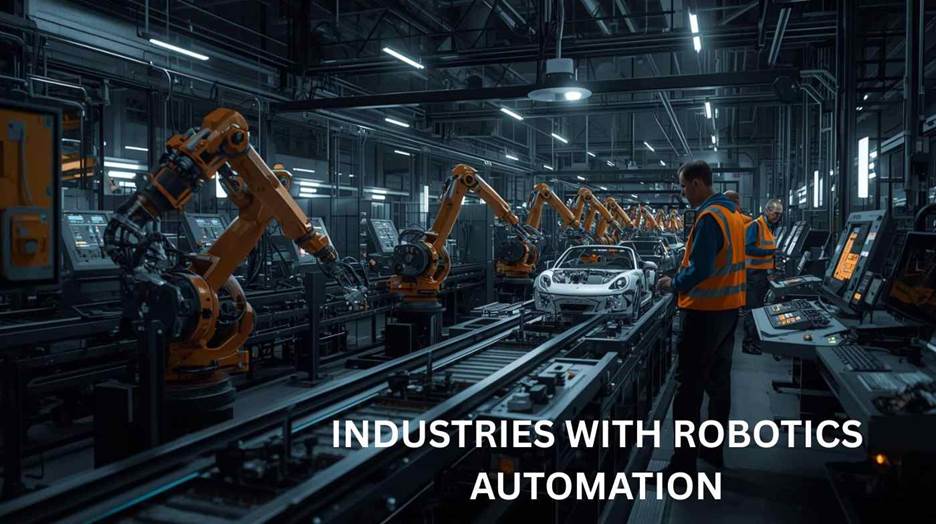In today’s fast-paced technological era, Robotics Automation has emerged as one of the most powerful tools reshaping industries across the globe. By combining robotics with intelligent automation systems, businesses are achieving higher efficiency, improved accuracy, and reduced operational costs. This article explores what Robotics Automation is, its advantages, applications across industries, challenges, and what the future holds for this revolutionary technology.
Table of Contents

Understanding Robotics Automation
What Is Robotics Automation?
Robotics Automation refers to the use of robotic systems integrated with automation technologies to carry out repetitive, dangerous, or highly precise tasks with minimal human intervention. Unlike simple machines, these systems are equipped with sensors, AI-driven software, and advanced mechanics that allow them to adapt to complex environments.
How It Works
At its core, Robotics Automation combines physical robotic machines with automated control systems. Robots are programmed or taught through machine learning to execute tasks such as assembly, quality checks, or material handling. These tasks are monitored and optimized by automation systems, ensuring continuous productivity.
Benefits of Robotics Automation
Improved Efficiency
Businesses adopting Robotics Automation experience streamlined processes. Robots can work around the clock without fatigue, leading to higher output and reduced downtime.
Enhanced Accuracy
Robotic systems excel at repetitive tasks where precision is essential. With Robotics Automation, error margins are significantly reduced, resulting in better product quality and consistency.
Cost Reduction
While the initial investment may be high, Robotics Automation lowers long-term operational costs. Reduced waste, faster production, and minimal rework save companies substantial amounts over time.
Safer Work Environments
By taking over hazardous jobs such as heavy lifting, toxic chemical handling, or high-temperature processes, Robotics Automation reduces workplace accidents and ensures worker safety.
Applications of Robotics Automation
Manufacturing Sector
The manufacturing industry has been one of the earliest adopters of Robotics Automation. From assembling cars to packaging goods, robots streamline production lines, improve speed, and maintain quality standards.
Healthcare Industry
In healthcare, Robotics Automation supports precision surgeries, patient monitoring, and even pharmaceutical production. Robots assist doctors in performing delicate procedures with greater accuracy.
Logistics and Warehousing
With the rise of e-commerce, Robotics Automation plays a crucial role in inventory management, sorting, and shipping. Automated guided vehicles and robotic arms make supply chains faster and more reliable.
Agriculture and Food Processing
Robotics Automation is also transforming agriculture by automating tasks like planting, harvesting, and food packaging. This ensures consistent quality and helps meet growing global food demands
.
Challenges of Robotics Automation
High Initial Investment
One of the main obstacles to adopting Robotics Automation is its cost. Small and medium-sized enterprises may find it difficult to afford the technology despite its long-term benefits.
Need for Skilled Workforce
Operating and maintaining Robotics Automation systems requires a skilled workforce trained in robotics, AI, and software management. The shortage of such expertise can hinder adoption.
Job Displacement Concerns
As robots take over repetitive tasks, concerns about unemployment grow. Although Robotics Automation creates new opportunities in tech-related fields, workers in traditional roles may feel threatened.
Integration Challenges
Not all industries can seamlessly integrate Robotics Automation into their existing systems. Compatibility with older equipment and the need for process redesigns can slow down implementation.
The Future of Robotics Automation
Integration with Artificial Intelligence
The future of Robotics Automation lies in deeper integration with AI and machine learning. Smarter robots will not only follow instructions but also make independent decisions based on real-time data.
Expansion into Service Industries
Beyond factories and warehouses, Robotics Automation is expected to grow in hospitality, education, and retail sectors. Robots may soon be part of customer service, cleaning, and personalized assistance.
Sustainable Development
Robotics Automation will play a significant role in promoting sustainability by optimizing energy use, minimizing waste, and supporting eco-friendly production processes.
The Human Perspective on Robotics Automation
Changing Work Roles
While some jobs may become obsolete, Robotics Automation encourages workers to shift toward higher-skilled roles. Human employees can focus on creativity, innovation, and problem-solving while robots handle repetitive tasks.
Collaboration Between Humans and Robots
The future is not about robots replacing humans but about collaboration. With Robotics Automation, people and machines can work together, enhancing productivity and safety.
Conclusion
Robotics Automation is more than just a technological advancement it is a global movement transforming industries and redefining the future of work. Its benefits in efficiency, accuracy, safety, and cost savings make it indispensable in today’s competitive market. While challenges like cost and workforce adaptation exist, the potential of Robotics Automation far outweighs these barriers. As industries continue to evolve, this technology will remain at the heart of progress, driving innovation and shaping a smarter, more sustainable future.